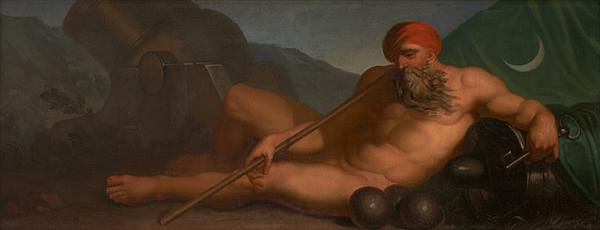When Nicolai Abildgaard returned home to Denmark in 1777 after a long sojourn abroad, he was appointed professor at the Royal Danish Academy of Fine Arts in Copenhagen. At the same time, he was also commissioned to carry out the decorations at Christiansborg Palace, which served as the king’s residence at that time. In the years that followed and all the way up until his death, Abildgaard increasingly devoted himself to interior design, restoration projects, architecture, and furniture design.
[1]Bosporus is an overdoor painting, meaning that it was as originally meant to be fitted above an entryway. The subject is an allegorical representation of the Bosphorus Strait, personified as a reclining river god with a large beard and a red turban. In his right hand and supported over one shoulder, the deity holds a green banner with the Turkish crescent moon. In his left hand he has a key, and he rests up against the rear end of a cannon surrounded by cannonballs. On the left side of the picture is a mortar aimed at the background.
Abildgaard presumably painted
Bosporus in the late eighteenth century for Hvedholm Castle on the island of Funen, for which he also created three other overdoor paintings.
[2] He created several overdoors for other settings, too, usually with allegorical subjects or scenes from antiquity. Some of the best known are four large overdoors featuring scenes from the history of Europe at Christiansborg Palace which unfortunately perished along with the rest of the palace in the fire of 1794. Abildgaard oversaw the decoration of Levetzau’s Palace (now Christian VIII’s Palace) at Amalienborg Palace, where overdoors were also created, including scenes associated with the four continents.
Bosporus was acquired in 1988 and it is the only work by Abildgaard in The David Collection. However, it is not the only overdoor painting as the collection also includes François Boucher’s
The Gallant Chinese (
B 275).
